Trossbach and Graffy’s on-stage chemistry palpable in Lab Theater’s ‘Burn This’
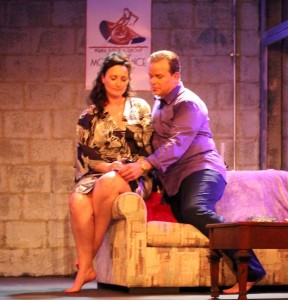 Burn This opened at the Laboratory Theater of Florida on February 3. Written by Lanford Wilson and directed by Anne Dodd, “Burn This” is a well-acted, highly entertaining four-actor play that explores the age-old phenomenon of opposites attract.
Burn This opened at the Laboratory Theater of Florida on February 3. Written by Lanford Wilson and directed by Anne Dodd, “Burn This” is a well-acted, highly entertaining four-actor play that explores the age-old phenomenon of opposites attract.
In this case, the positive pole in this magnetic polarity is a dancer-turned-choreographer by the name of Anna, sensitively and sensationally portrayed by Lab Artistic Director Annette Trossbach. The negative pole is a mercurial Jersey 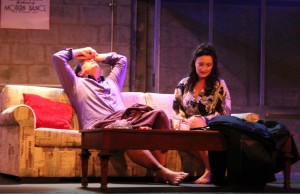 boy by the name of Pale, reprised by Trossbach’s acting equal, Paul Graffy. Trossbach and Graffy have starred together before (in last season’s Stage Kiss) and they bring out the best in each other’s performances. Their on-stage chemistry is almost palpable in Burn This.
boy by the name of Pale, reprised by Trossbach’s acting equal, Paul Graffy. Trossbach and Graffy have starred together before (in last season’s Stage Kiss) and they bring out the best in each other’s performances. Their on-stage chemistry is almost palpable in Burn This.
Anna lives a classical bohemian existence. She is 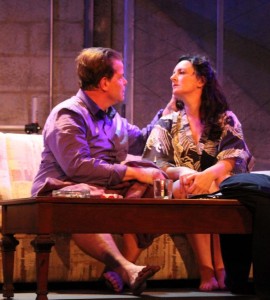 romantically involved with a good-looking well-to-do filmmaker by the name of Burton while living in a spare industrial-warehouse studio apartment with not one, but two gay roommates … well, at least until one of them is killed with his lover in a freak boating accident. Anna is compelled to place her own grief on hold during the funeral because poor Robbie’s family had no inkling he was gay. Hell, they did not even know that he was a gifted dancer. But since the poor girl (who, we are told, grew up protected) feels it is not her place to set them straight (pun intended), the compassionate-to-a-fault
romantically involved with a good-looking well-to-do filmmaker by the name of Burton while living in a spare industrial-warehouse studio apartment with not one, but two gay roommates … well, at least until one of them is killed with his lover in a freak boating accident. Anna is compelled to place her own grief on hold during the funeral because poor Robbie’s family had no inkling he was gay. Hell, they did not even know that he was a gifted dancer. But since the poor girl (who, we are told, grew up protected) feels it is not her place to set them straight (pun intended), the compassionate-to-a-fault 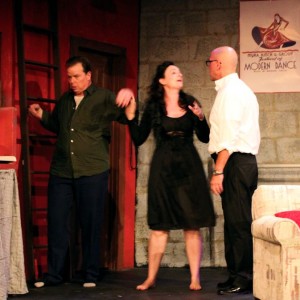 Anna simply allows them to believe that she was Robbie lover.
Anna simply allows them to believe that she was Robbie lover.
But Robbie’s older brother, Pale, knows the truth about his brother’s sexual orientation, and not long after Anna returns to New York, Pale shows up drunk and coked up at five in the freaking morning to collect his brother’s personal effects. After nearly breaking down the door, he launches into a tirade about the neighborhood (which is dying of “crotch rot”), parking (he had to brandish a tire iron to keep some guy in a green 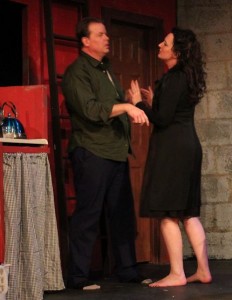 Trans Am from snaking his space while he was in the midst of parallel parking), and how he resents Anna for leaving messages for him everywhere he turns, including with the bartender at the restaurant he manages. But istead of lunging for the phone to call 9-1-1, the bewildered young girl just looks at him and asks, “Do I know you?”
Trans Am from snaking his space while he was in the midst of parallel parking), and how he resents Anna for leaving messages for him everywhere he turns, including with the bartender at the restaurant he manages. But istead of lunging for the phone to call 9-1-1, the bewildered young girl just looks at him and asks, “Do I know you?”
As it turns out, Anna does know the man lurking beneath the gruff exterior. Sure, they met at the funeral, but grief recognizes its companion. However, Pale’s grief is amplified by guilt – not just because he did not know a thing about his younger brother, but because when he’d discovered his brother’s sexual orientation, he’d 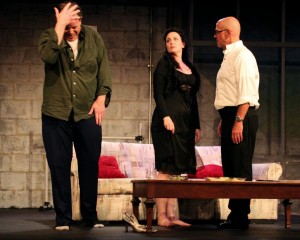 wished him dead. And two days later, he was.
wished him dead. And two days later, he was.
In both Anna and Pale, Lanford Wilson creates two of live theater’s most deeply conflicted, nuanced and complex characters, but his genius inheres in withholding from the audience any explanation as to why they are inexplicably, incomprehensibly and incongruously attracted to each other. Is it their mutual grief? Is Anna just attracted to 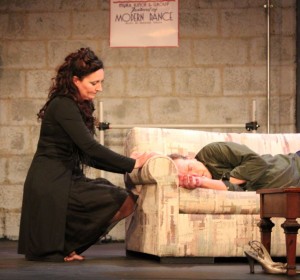 bad boys? Does something beneath the surface of this temperamental bad boy stir some motherly, nurturing instinct in her? Anna’s remaining roommate, Larry, opines at one point that she should probably “just marry [Burton] and buy things.” And although she protests she doesn’t want Pale and never intended to fall for him, he stimulates her, frightens her, and ultimately inspires her. That’s just the way chemistry works. Burton may be perfect for Anna, but he doesn’t do a thing for
bad boys? Does something beneath the surface of this temperamental bad boy stir some motherly, nurturing instinct in her? Anna’s remaining roommate, Larry, opines at one point that she should probably “just marry [Burton] and buy things.” And although she protests she doesn’t want Pale and never intended to fall for him, he stimulates her, frightens her, and ultimately inspires her. That’s just the way chemistry works. Burton may be perfect for Anna, but he doesn’t do a thing for 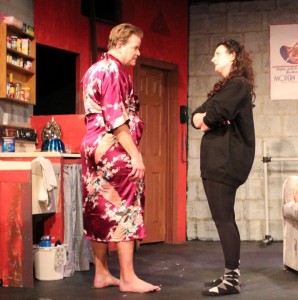 her emotionally or creatively. Pale may be apples to Anna’s oranges, but the heart wants what the heart wants, and it is this dimension of their characters that Trossbach and Graffy so ably and aptly draw out.
her emotionally or creatively. Pale may be apples to Anna’s oranges, but the heart wants what the heart wants, and it is this dimension of their characters that Trossbach and Graffy so ably and aptly draw out.
A more endearing love story does take place in Burn This. It resides in the relationship between Anna and her supportive and understanding roommate, Larry, played by Lab newcomer Brandon Somers. Somers is masterful as the witty, sometimes snarky, Larry, who comes in and out 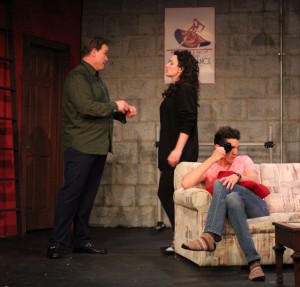 of scenes to make pithy observations and lighten the often heavy and somber mood shared by the other three characters. True, he has his own constellation of emotional problems and self-doubt (he becomes an ad man out of fear he cannot make it on or off Broadway as a dancer), which Somers uses to cast his character as an equally-complex, multi-dimensional human being.
of scenes to make pithy observations and lighten the often heavy and somber mood shared by the other three characters. True, he has his own constellation of emotional problems and self-doubt (he becomes an ad man out of fear he cannot make it on or off Broadway as a dancer), which Somers uses to cast his character as an equally-complex, multi-dimensional human being.
After a three-year hiatus, Rob Green returns to the Lab Theater boards to play the role of Burton, a 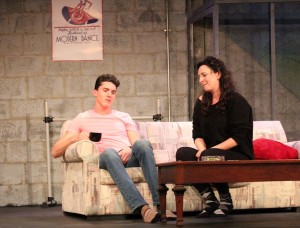 screenwriter who refrains from writing something authentic out of fear it will not be commercially successful and refuses to explore his own sexual orientation even after being titillated by a doorway encounter with a man during a snowstorm years before. And it is Burton who gives the play its title. “Make it personal, tell the truth, and then write ‘Burn This’ on it,” he says early on. And it is precisely this advice that Larry puts to use to
screenwriter who refrains from writing something authentic out of fear it will not be commercially successful and refuses to explore his own sexual orientation even after being titillated by a doorway encounter with a man during a snowstorm years before. And it is Burton who gives the play its title. “Make it personal, tell the truth, and then write ‘Burn This’ on it,” he says early on. And it is precisely this advice that Larry puts to use to 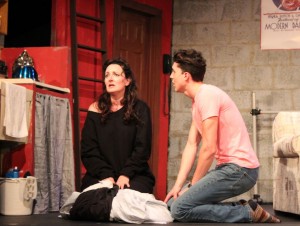 induce Anna to act on her true feelings toward Pale.
induce Anna to act on her true feelings toward Pale.
It is personal for each of the characters in this emotional rollercoaster of a play, but like each of us, Anna, Pale, Larry and Burton struggle to recognize the truth, especially in themselves.
If you relish great writing, terrific acting and well-drawn characters, then Burn This is for you. It is entertaining on 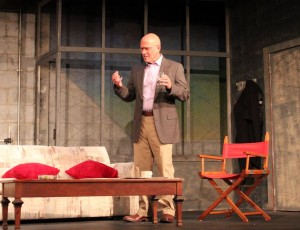 multiple planes; challenging both emotionally and intellectually. It is theater at its best.
multiple planes; challenging both emotionally and intellectually. It is theater at its best.
February 5, 2017.
RELATED POSTS.













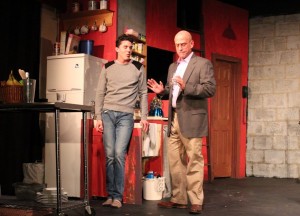

 Tom Hall is both an amateur artist and aspiring novelist who writes art quest thrillers. He is in the final stages of completing his debut novel titled "Art Detective," a story that fictionalizes the discovery of the fabled billion-dollar Impressionist collection of Parisian art dealer Josse Bernheim-Jeune, thought by many to have perished during World War II when the collection's hiding place, Castle de Rastignac in southern France, was destroyed by the Wehrmacht in reprisal for attacks made by members of the Resistance operating in the area. A former tax attorney, Tom holds a bachelor's degree as well as both a juris doctorate and masters of laws in taxation from the University of Florida. Tom lives in Estero, Florida with his fiancee, Connie, and their four cats.
Tom Hall is both an amateur artist and aspiring novelist who writes art quest thrillers. He is in the final stages of completing his debut novel titled "Art Detective," a story that fictionalizes the discovery of the fabled billion-dollar Impressionist collection of Parisian art dealer Josse Bernheim-Jeune, thought by many to have perished during World War II when the collection's hiding place, Castle de Rastignac in southern France, was destroyed by the Wehrmacht in reprisal for attacks made by members of the Resistance operating in the area. A former tax attorney, Tom holds a bachelor's degree as well as both a juris doctorate and masters of laws in taxation from the University of Florida. Tom lives in Estero, Florida with his fiancee, Connie, and their four cats.